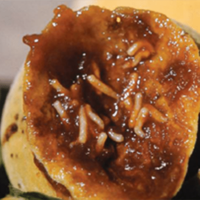Host plants
Medfly and Natal fruit fly are known to infest over 260 species of fruits, flowers, vegetables and even nuts, but thin-skinned, ripe succulent fruits and berries are preferred. In the Western Cape, these include all deciduous fruits and wine and table grapes and a great many other fruits and berries of trees or shrubs, wild or domestic. Examples of fruits readily infested include stone fruit, table grapes, guava, loquat, litchis, mangoes and wild plum (Harpephyllum caffrum), while lemon, avocado and olive are examples of fruit with lower infestation.
Damage
In both species only the larval stages causes damage. Eggs are deposited just under the skin of mostly ripe or ripening host fruits (illustrated); oviposition sites generally resemble a discoloured pin-prick spot on the fruit skin. The resulting larvae feed on the fruit tissue, tunnelling towards the fruit centre. Under high fruit fly infestation situations, even green fruit can be attacked. The feeding activity together with subsequent infection by micro-organisms and/or secondary pests can reduce the fruit to a pulpy mass, as illustrated.
Medfly is one of the world’s most destructive fruit pests, due to its wide distribution, very wide host range, and ability to tolerate cooler climates compared to most fruit fly species. Natal fruit fly has a lower pest status due to its narrower distribution and host range. Both are international quarantine pests. In uncontrolled conditions, crop losses on some fruits by either or both species can reach 100%.
Life history
The life history is similar for both species. Duration of the different life stages is largely governed by temperature and availability of food. Three to about six generations can occur per year. Under favourable conditions female fruit flies become sexually mature and capable of laying eggs about five days after emergence. After mating they actively seek out ripening fruit and deposit their eggs in a small cavity just below the fruit skin. A single female can lay 1-10 eggs in a cavity, but 50 or more eggs from multiple females can be found in one cavity. After 3-7 days the larvae hatch and start feeding on the flesh of the fruit. Larvae reach maturity from about 10-45 days later, after which they leave the fruit, fall to the ground and pupate just below the surface in the soil. About 10-50 days later the adult flies emerge, they crawl up to the soil surface, and the cycle is complete.
During warm conditions in ripe fruit, the life cycle can be completed in as little as 3-4 weeks, but this can increase to about two or three moths in winter or when eggs are laid in greener fruit. Adult flies can live from 2-6 months under favourable conditions, but die within four days if food is unavailable. Fruit flies are present throughout the year, moving from one fruit kind to another, both cultivated and wild, as they ripen in succession. Peak numbers occur in late summer and autumn. Natal fruit fly prefers cooler and more humid conditions, while medfly predominates in hotter, drier conditions.
Natural enemies
These include entomopathogenic bacteria (e.g. Bacillus thuringiensis, Saccharopolyspora siniosa), fungi (e.g. Entomophthora spp., Beauveria bassiana, Metarpizium anisopliae), and nematodes (Steinernema spp., Diplogaster sp.), a microsporidian, Nosema tephritidae, ants and spiders. The largest contribution to biological control is by numerous hymenopterous parasitoids. Elsewhere some species are mass-reared for augmentative releases as part of an integrated, area-wide management approach, including species of the braconid genera Diachasmimorpha and Fopius.
Management
Biological control of fruit flies has not always been regarded as successful when measured by economic returns, due partly to the very low economic threshold for fruit fly damage. Classical biological control is challenged by a low fecundity of parasitoids compared to fruit flies, poor detection of fruit fly populations by parasitoids, and fruit flies having a degree of refuge from parasitoid attack in large or thick-skinned fruit (larvae) or under dense litter (pupae).
Other management practices include monitoring populations with lure-bated traps (on which all decisions on interventions should be based), control of host plants (removal or fruit-stripping), sanitation (cleaning-picking of orchards and vineyards; destruction of infested/fallen fruit), application of fruit fly bait (usually a protein attractant mixed with a synthetic or natural insecticide), the use of bait stations (so-called “attract & kill” technology), augmentative releases of parasitoids, and where justified, use of the sterile insect technique (STI). It is widely recognized that fruit flies are best managed by an area-wide, integrated approach incorporating as many of the above-mentioned practices as possible.








